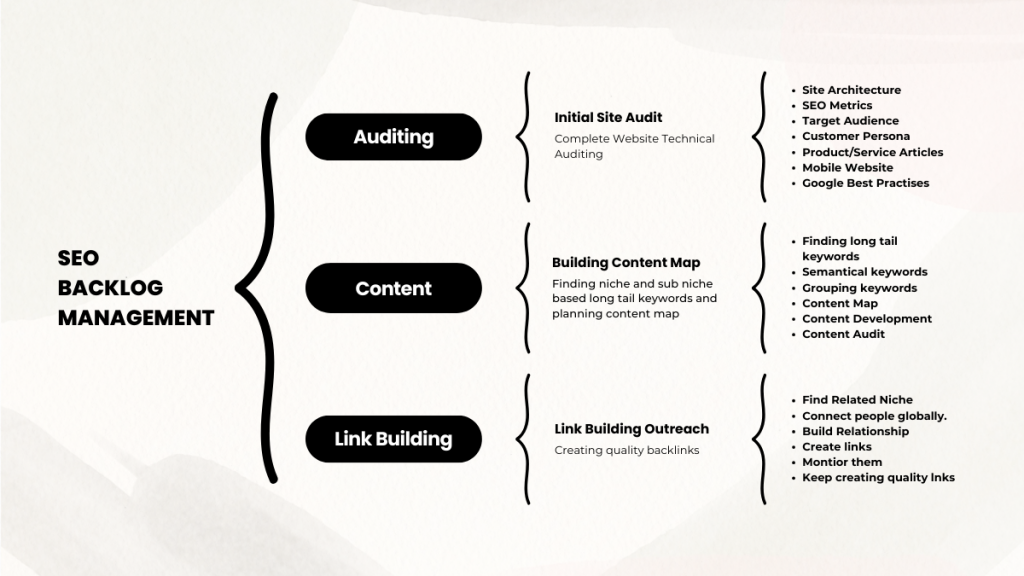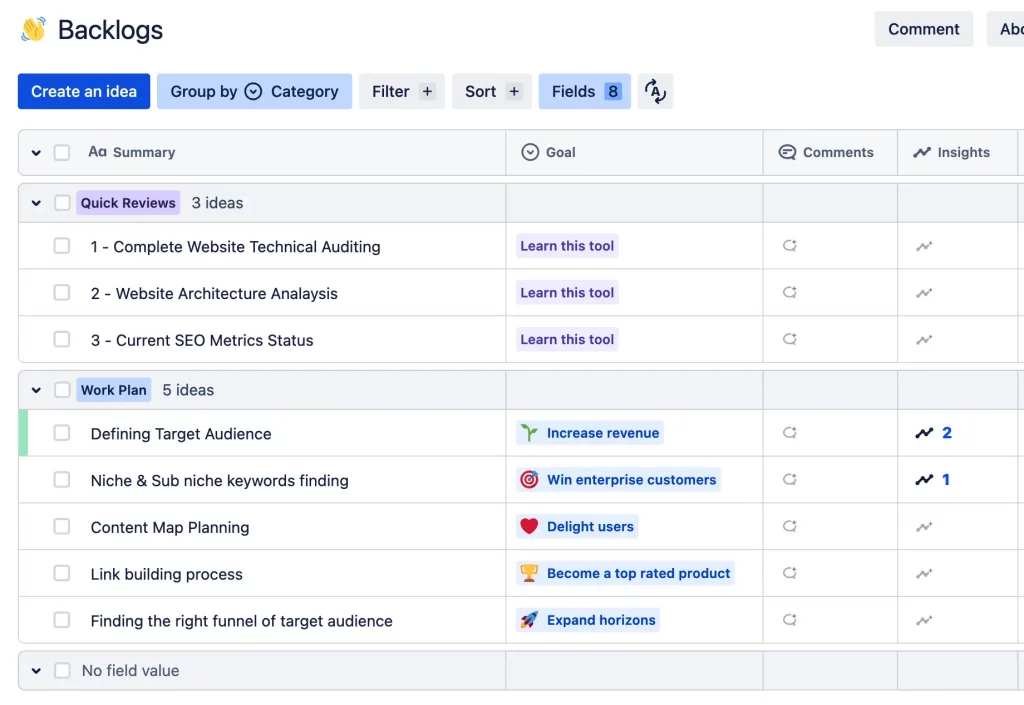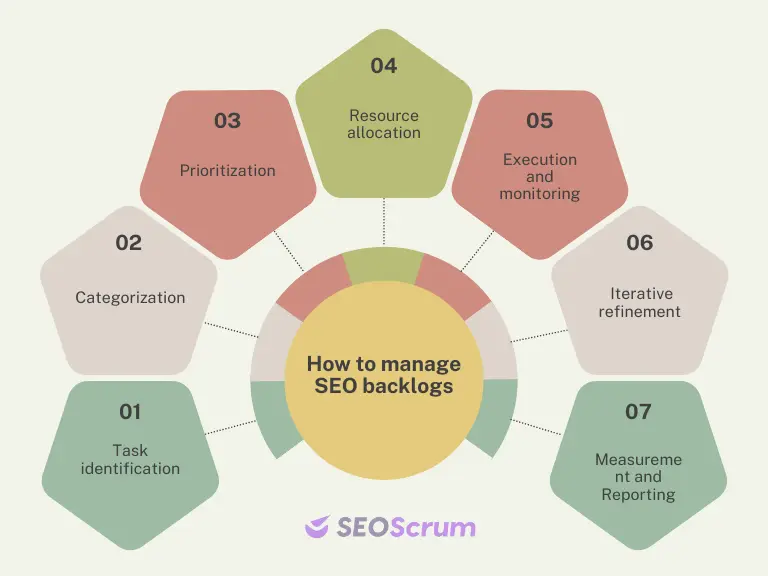SEO backlog management essentials: Driving organic growth

Do you agree with me that managing the SEO tasks is super important?
To stay cool with your SEO business, you need to first figure out
- What needs to be done first
- Who will take responsibility for those operations
- How quickly your SEO business gets adapted to the fast-changing SEO game.
Just set your SEO team to work together, let them take ownership of their tasks, and set yourself for long-term success with the help of an efficient SEO backlog.
Fortunately, this article focuses on critical skills in SEO backlog management.
I am sure that this breaking down of SEO backlog processes in a simplest way is going to give a special boost to your SEO business and will let you reach new levels of success.
Table of Contents
What is Backlog in Agile Methodology?
Backlog in agile is a prioritized list of features, user stories, bug patches, and other activities that need to be finished within a project.
Who is in charge of this backlog? The product owner? Yes! You got it right!
He can use the backlog as a super handy book which acts as a living record that changes when a new need arises or an old need is solved.
The backlog also allows the team to see what has to be done next and to focus on the most important work if they run short of time.
Finally, it is going to be a mini-GPS for your SEO project that keeps you on track and directs you in the right direction.
What is an SEO backlog?
The SEO backlog in agile SEO is a checklist of tasks that includes everything that starts from technical issues to content quality, all aiming to improve the website’s visibility and its online authority.
You can easily create a strong SEO strategy by selecting tasks from several categories and monitoring how well they fit with each other.
To make it simple, we can organize these tasks based on technical, on-page, off-page and content-related tasks.
Technical tasks
These tasks include tweaking the technical stuff on the website that will let the target audience to easily find them.
Examples: Integrating scheme markup, increasing site speed, fixing crawl errors, configuring robots.txt and XML sitemaps, mobile friendliness, and making HTTPS secure.
On-Page tasks
On-page tasks include structuring each web page optimally to improve its relevance and authority in search engines for certain keywords or topics.
Examples: Optimization of the keywords in the titles, meta descriptions, subheadings and content, interlinking improvement, optimizing URL structures, and user experience (UX) elements such as readability, and multimedia integration.
Off-Page tasks
Here the efforts are directed at increasing the trustworthiness, relevance, and authority of a website through signals coming from other reliable websites besides the citation of links.
Examples: Strategies for earning high-quality backlinks through outreach and content promotion, community and forum participation, guest posting on authoritative websites, and managing online reviews and citations.
Content-related tasks
These are geared towards the development, optimization, and management of content assets that act as magnets to attract relevant searchers and attract the audience by addressing their information needs and search intent.
Examples: Include the keyword-targeted blog posts, complete authoritative and detailed guides, conduct content optimization for both search engines and the experience of users, do content audits, and strategize content topics and formats by using keyword research and audience insight.
Features of SEO backlogs
When it comes to SEO, backlogs become trusty road maps and ultimate hubs for all tasks, resources, requirements, communication and ideas for the project. Here are some cool SEO backlog management features.
Dynamic: The agile backlog is ever-changing – it can be updated, amended, or rewritten as the project priorities shift or new information surfaces.
Prioritized: Backlog items are arranged according to their weight for the project or customer. This guarantees that the priority essential features or functions are tackled first, making sure that the project yields the highest impact.
Detailed: Every entry in the backlog, feature, or bug, is described deeply enough to make it clear and comprehensible for the development team. Here you can put the acceptance criteria, user stories, or any other essential inputs required for implementation.
Collaborative: Backlog refinement is a collective effort of all the stakeholders, product owners, and development teams. Frequent dialogue and reviews maintain synchronization of targets and expectations.
Visible: The backlog is transparent and it has access to all team members so it is possible to get information on future work and progress. This makes all the members take responsibility and be communicative within the team.
Time-boxed: The agile backlog is usually iteration and sprint-specific, and the items selected for execution depend on the team’s capability and sprint objectives.
Flexible: Agile backlogs are flexible tools to quickly respond to any change. Moreover, in cases where new information is discovered or there is a change in priorities, the backlog can be revised to match the current direction of the project.
Refined: Backlog refinement is an ongoing process that involves reviewing, updating, and reprioritizing tasks from time to time to be in line with the goals of the project and the needs of the customer.
How user stories and epics classify SEO backlogs?
User stories and epics can be strong forms for structuring SEO tasks in the backlog by helping to make the work more customer-oriented and user-centric.
User Stories
These are short and easy-to-understand descriptions of a feature or functionality that a user or your clients wants to achieve. In the context of SEO, user stories can represent user intents or behaviors that the SEO efforts seek to accommodate.
For example
“As a potential customer, I want to see a clear and concise meta description on the search engine results page so that I can quickly understand what the webpage is about and decide if it meets my needs.”
SEO tasks can be framed in user stories which enables a team to focus on the needs and goals of the target audience leading to better and more efficient optimization results.
Epics
These are the broader, all-embracing projects that include related user stories. In light of SEO, epics can be higher-level objectives or areas that have several steps to complete them.
For example
“Improve website authority and backlinks profile.”
“Improve website content quality and believability of key landing pages.”
Epics provide context and direction for SEO tasks, giving a team the capability to break down broader goals into manageable tasks and to set the right priorities according to the backlog.
Using user stories and epics to build SEO tasks helps SEO teams stay user-oriented, meet business targets, as well as follow SEO strategies holistically. This technique brings clarity, cooperation, and customer-focused attitude which leads to more effective and impactful SEO performance.
Sample templates to categorizing and prioritizing SEO tasks
I have provided a simple example of backlogs when any agency start with the new project.

How to manage SEO backlogs?
You are into the world of SEO backlogs. In just a few simplified steps, you will come to know how to manage these SEO backlogs and keep your website climbing the SERP.

Step 1: Task identification
In the process of SEO backlog management, the initial step is to determine which tasks are essential to enhance the website ranking.
The tasks may include technical issues, updating the website, backlinking, and creating or improving the content.
Step 2: Categorization
Once we are clear with the list of tasks to be done, we need to organize them according to their respective categories. This supports us in keeping tasks tidy and focused.
Hope you are clear with the categories that comes under SEO backlogs as we have already mentioned-above in this article.
Step 3: Prioritization
Based on the degree of urgency, all tasks are ordered systematically where the high-priority tasks will be considered first.
On the same time, we also need to check the availability of the resources to carry out the high-priority tasks.
Step 4: Resource allocation
When the prioritization is done, resources like timing, budget, and human resources are used to execute the tasks.
This incorporates giving tasks to team members or contracted suppliers, determining deadlines, and making sure that sufficient resources are available to complete the tasks well.
Step 5: Execution and monitoring
Now, the priority list is ready for all tasks. All we have to do now is to keep an eye on how things are going and should track their progress.
This can be done through agile methodologies like Scrum or Kanban through frequent sprint planning, daily stand-ups, and reflective retrospectives. The primary goal is to provide continuous improvement throughout the process.
Step 6: Iterative refinement
SEO Backlog management is an iterative cycle through which tasks are evaluated, updated, and reprioritized as business needs, search engine algorithms and market trends shift.
On-going backlog refinement makes certain that the strategy is aiming at the right targets and is flexible enough to meet new challenges.
Step 7: Measurement and Reporting
Lastly, SEO effort results are monitored and reported using KPIs like organic traffic, keyword ranks, conversion rates, and revenues. Such data will help evaluate SEO efficiency and guide future backlog management.
Finally, achieving successful SEO projects depends on a properly executed backlog management system, focusing on the most important tasks to be done strategically to get measurable business results in the end.
Examples of SEO Backlogs for an E-commerce SEO Project
Below listed examples illustrate a wide range of urgent tasks for the SEO of an e-commerce website. Prioritization of tasks within each category will depend on the business objective, resource availability, search rankings, and user experience impacts.
Technical SEO tasks
- Add structured data markup (Schema.org) to product pages.
- Improve website velocity by compressing pictures, and minimizing CSS/JS files.
- Take care of crawl errors that you have found in Google Search Console.
- Secure canonical tagging of product variants and pagination.
On-Page SEO tasks
- Perform keyword research to select product-related key phrases that have good search potential.
- Optimize product titles and meta-descriptions by infusing keywords that are relevant.
- Writing impressive and keyword-optimized product descriptions is a must.
- Build links between product pages with similar products and category pages.
- Optimize alt tags of images by including precise keywords and product names.
Off-Page SEO tasks
- Create a plan for getting valuable backlinks from reputable and specialized sources.
- Incorporate product feeds into shopping aggregators and comparison sites.
- Invest in posts on social media for brand awareness and run influencer campaigns.
- Track and maintain online reviews and scores on online platforms and online marketplaces.
Content-related SEO tasks
- Set a blog section aside on the e-commerce website making it possible to post informative articles, guides, and tutorials related to products.
- Set up a content calendar with blog post scheduling of the most related keywords and subjects.
- Take advantage of category pages and implement them with original content and H1s rich in keywords.
- Apply user-generated content concepts including product reviews and testimonials.
User experience (UX) optimization
- Run usability testing to pinpoint and resolve any usability problems on the website that can be navigation difficulties or optimize the checkout process.
- Adopt the responsive design framework to ensure that the website serves all types of devices efficiently.
- For improved visual effects and quicker download times, optimize your photos and videos.
- Add keyboard navigation and screen readers to make the website more accessible to those with disabilities.
E-commerce analytics and reporting
- Install Google Analytics and Google Tag Manager to measure website traffic, user behavior, and conversion metrics.
- Develop custom dashboards and reports for KPI tracking with traffic sources, conversion rates, and revenue.
- Implement e-commerce tracking to analyze product performance, cart abandonment rates, and customer lifetime value.
- Implement event tracking to check particular actions. Clicks on product links or form submissions.
Local SEO optimization
- Get and optimize Google My Business listings for physical store locations, indicating correct business information, categories, and images.
- Incorporate the local keywords into website content, meta tags, and structured data markup to boost the site’s visibility in local search results.
- Spur and manage customer reviews on local review platforms including Yelp, TripAdvisor, and Facebook.
- Adjust landing pages to local keywords and apply local business schema markup to boost local search result relevance.
Schema markup implementation
- Implement the product schema markup which will enable search engines to fetch more detailed information about each product, such as price, availability, and reviews.
- Use breadcrumb schema markup to better the site navigation and increase the visibility in search engines.
- Explore other schema markup types for example FAQPage or AggregateRating to add more visibility and richness to search results.
Competitor analysis and monitoring
- Discover main e-commerce competitors and carry out an in-depth SEO analysis that covers their keywords, backlink profiles, and content strategies.
- Monitor competition’s search engine rankings, traffic trends, and social media activity to notice opportunities and threats.
- By using competitive intelligence tools to observe competitor performance and compare them with the industry’s accepted standards.
Top 8 SEO backlog management tools
Are all the procedures involved in SEO backlog management overwhelming you?
Stay cool!
With our top 8 SEO backlog management tools, you are completely covered.
Just take a look and get to know how these tools can assist you in managing your SEO backlogs effectively.
1. SEOScrum.io
SEOScrum.io is the best SEO project management software that is exclusively designed with SEO backlog features. In contrast to other leading tools, SEOScrum.io is equipped with a blend of SEO methods and Scrum ideas.
It provides a transparent communication, iterative development, and issue prioritization mechanism to SEO teams by giving them an exclusive environment.
SEOScrum offers teams the ability to organize their SEO activities more efficiently, adapt to changing priorities, and show data in the always-present digital environment. These tools include sprint planning, backlog grooming, and real-time analytics.
2. Trello
With Trello, a versatile project management tool, tasks are arranged using cards, lists, and boards. SEO teams can set up boards for various initiatives or campaigns and use cards to signify each task.
Cards can be moved between lists to show their state (To-do, in progress, finished), and members of the team will be inputting comments, attachments, and due dates.
3. Jira
Jira is a powerful Agile project management tool that is widely used by software development teams, but the principle can be applied to SEO backlog management as well.
A team can develop projects, epics, and user stories to reflect the SEO tasks and prioritize them using the customizable workflows and boards.
Jira comes with out-of-the-box reporting and integration with other tools, making it possible to monitor the projects thoroughly.
4. Asana
Asana is a powerful task manager where one can create, assign, and track the tasks for his team members.
Through Asana SEO experts can set up tasks for the various areas of SEO (e.g. technical SEO, content optimization) and place them in lists or boards within each project.
To increase efficiency at work, Asana has features including task dependencies, deadlines, and integrations with other programs.
5. Monday.com
A visual project management platform called Monday.com features dashboards, timelines, and boards that can all be customized for organizing and tracking work.
SEO teams can use boards to depict their backlogs and use columns for tasks to categorize based on priority, status, or type.
Monday.com’s ease of use and collaborative tools allow teams to manage SEO tasks and workflows in the most efficient ways possible.
6. Notion
The notion is a multi-functioning workspace that integrates note-taking, project management, and collaboration functionalities. Organized tracking of progress and maintaining a repository of lessons learned.
These are a few things that the SEO teams can do with the help of databases and templates. Notion grants flexibility along with the option to customize which is an enabling factor for team members to adapt their work processes to their specific needs and preferences.
7. ClickUp
Goal-setting, project tracking, and task management are the main features of ClickUp. It is a single software.
SEO professionals can use ClickUp to create tasks, distribute them among team members, and control the advancement of the workflow with the help of numerous customizable boards and views.
8. Google Sheets/Excel
For teams that seek simplicity and customization, SEO can use Google Sheets or Excel spreadsheets for the creation and maintenance of their backlogs.
Teams can have the task list in either spreadsheets or projects and then prioritize them using color-coding or conditional formatting and tracking progress through status, due dates, and assignee columns.
Google Sheets/Excel is prevalent due to the presence of flexibility and familiarity it gives to small teams with specific needs.
Conclusion
To conclude, the successful backlog management of SEO is the key factor for ultimately getting the desired results from digital marketing campaigns.
An SEO team can enhance a website’s search engine results, visibility, and significance on search engines by organizing and executing several SEO features following a well-defined approach to prioritizing work.
Teams will be able to stick to an agile and proactive approach to their optimization efforts by aligning their backlog with search engine algorithms, company objectives, and marketing dynamics through continuous refinement and adaptation.
Finally, an arranged flow of SEO tasks will be like a map in the rapidly changing online world that will allow companies to have their growth and their competitive power over the virtual world.

